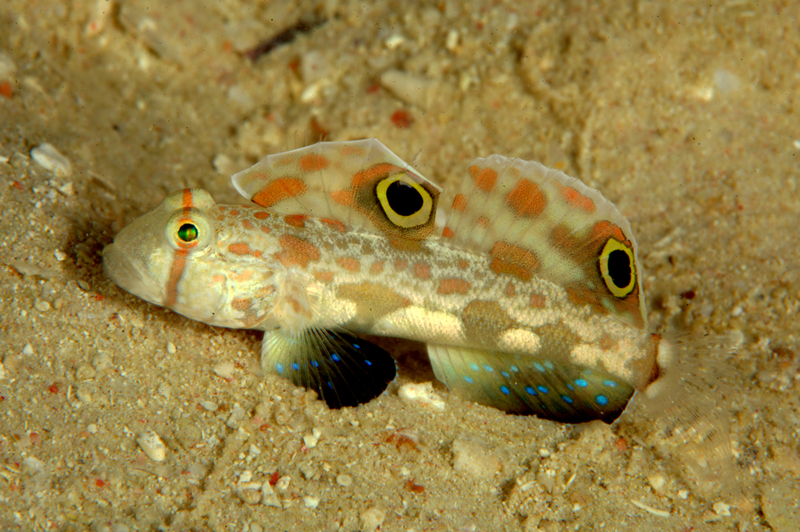- Classification
- ACTINOPTERYGII
- PERCIFORMES
- GOBIIDAE
- Signigobius
- biocellatus
Crab-eye Goby, Signigobius biocellatus Hoese & Allen 1977
Other Names: Crab-eyed Goby, Four-eyed Goby, Signal Goby, Twinspot Goby, Twin-spot Goby

A Crab-eye Goby, Signigobius biocellatus, on the Great Barrier Reef, Queensland. Source: Klaus Stiefel / Flickr: Pacific Klaus. License: CC BY Attribution-Noncommercial
Summary:
A very distinctive goby with a conspicuous dark ocellus on each dorsal fin, and large dark blue-spotted pelvic and anal fins.
Fantastic video of a pair of Crab-eye Gobies.
Video of a Crab-eye Goby upclose.
Fantastic video of a pair of Crab-eye Gobies.
Video of a Crab-eye Goby upclose.
Cite this page as:
Dianne J. Bray, Signigobius biocellatus in Fishes of Australia, accessed 20 Apr 2024, https://fishesofaustralia.net.au/home/species/4161
Crab-eye Goby, Signigobius biocellatus Hoese & Allen 1977
More Info
|
Distribution |
Known in Australian waters from Scott Reef to Ashmore Reef, Western Australia, and from Tijou Reef to off Townsville, Great Barrier Reef, Queensland. Found elsewhere in the tropical, west-central Pacific. Inhabits sandy, silty or rubble bottoms around coral in lagoons and coastal bays. Individuals or pairs build burrows in the substrate. |
|
Features |
Meristic features: Dorsal fin VII, 10-11; Anal fin I, 10 - 11. |
|
Feeding |
Feeds by sifting small interstitial invertebrates from mouthfuls of sand. |
|
Biology |
Forms monogamous pairs. |
|
Etymology |
Signigobius is from the Latin signus meaning 'mark' and gobius a fish genus. The species name biocellatus is from the Latin bi meaning 'two' and ocellatus meaning 'small eye spots' in reference to the prominent ocelli on the dorsal fins. |
|
Species Citation |
Signigobius biocellatus Hoese & Allen, 1977, Japan. J. Ichthyol. 23(4): 200, figs 1-3, 4A, 5A. Type locality: Linnet Reef, Queenslaand. |
|
Author |
Dianne J. Bray |
Crab-eye Goby, Signigobius biocellatus Hoese & Allen 1977
References
Allen, G.R. 1993. Fishes of Ashmore Reef and Cartier Island. Records of the Western Australian Museum, Supplement 44: 67-91.
Allen, G.R. 1997. Marine Fishes of Tropical Australia and South-east Asia. Perth : Western Australian Museum 292 pp. 106 pls.
Allen, G.R. & M.V. Erdmann. 2012. Reef fishes of the East Indies. Volumes I-III. Tropical Reef Research, Perth Australia.
Coleman, N. 1981. Australian Sea Fishes North of 30°S. Lane Cove, NSW : Doubleday Australia Pty Ltd 297 pp.
Hoese, D.F. & Allen, G.R. 1977. Signigobius biocellatus, a new genus and species of sand-dwelling coral reef gobiid fish from the western tropical Pacific. Japanese Journal of Ichthyology 23(4): 199-207 figs 1-5
Hutchins, J.B., Williams, D.McB., Newman, S.J., Cappo, M. & Speare, P. 1995. New records of fishes for the Rowley Shoals and Scott/Seringapatam Reefs, off north-western Australia. Records of the Western Australian Museum 17: 119-123.
Kuiter, R.H. 1992. Tropical Reef-Fishes of the Western Pacific, Indonesia and Adjacent Waters. Jakarta : PT Gramedia Pustaka Utama 314 pp. pls.
Kuiter, R.H. 1996. Guide to Sea Fishes of Australia. A comprehensive reference for divers and fishermen. Sydney, NSW, Australia : New Holland Publishers xvii, 434 pp.
Myers, R.F. 1999. Micronesian Reef Fishes. A comprehensive guide to the coral reef fishes of Micronesia. Guam : Coral Graphics vi 330 pp. 192 pls.
Randall, J.E., Allen, G.R. & Steene, R. 1990. Fishes of the Great Barrier Reef and Coral Sea. Bathurst : Crawford House Press 507 pp. figs.
Randall, J.E., Allen, G.R. & Steene, R. 1997. Fishes of the Great Barrier Reef and Coral Sea. Bathurst : Crawford House Press 557 pp. figs.
Russell, B.C. 1983. Annotated checklist of the coral reef fishes in the Capricorn-Bunker group, Great Barrier Reef, Australia. Great Barrier Reef Marine Park Authority. Special Publication Series 1: 1-184 figs 1-2








